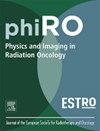人工智能评估中度次分割放疗期间前列腺体积变化
IF 3.4
Q2 ONCOLOGY
引用次数: 0
摘要
背景:在MRI -linac上每日获得用于放疗(RT)计划的诊断质量MRI允许对患者的解剖结构进行纵向评估。本研究调查了磁共振引导下前列腺体积的变化。这些变化是通过临床用于日常在线适应的人工描绘以及人工智能(AI)的自动分割来评估的。评价了两种方法的一致性和一致性。方法对45例接受60 Gy放射治疗的患者进行每日计划MRI扫描,分20组提取前列腺体积。这些卷是在在线自适应治疗计划工作流程中手工编辑的。人工智能使用内部开发的nnU-net对前列腺癌患者进行回顾性重新分割。每个分数的体积被归一化为患者第一个分数的体积,以确定可能的时间趋势。结果人工分割和自动分割均能增加前列腺平均体积。然而,基于人工分割,在第12个分数处出现峰值,为初始体积的106.8%,而基于自动分割,在第5个分数处达到峰值,平均增加110.8%。自动分割的体积标准偏差(5.2%)与人工描绘(12.7%)相比,分数之间的变化从3.6%减少到2.6%,表明自动分割的一致性更好。结论本地训练的神经网络自动分割比临床人工划定更一致。在剩余的治疗过程中,前列腺体积在减少后平均增加了110.8%,达到了5分之一。本文章由计算机程序翻译,如有差异,请以英文原文为准。
Volume change of the prostate during moderately hypo-fractionated radiotherapy assessed by artificial intelligence
Background
Diagnostic quality MRI acquired daily for radiotherapy (RT) planning on an MR-linac allows longitudinal evaluation of the patients’ anatomy. This study investigated changes in prostate volume during MR-guided RT. The changes were assessed from manual delineations used clinically for daily online adaptation as well as automated segmentation by artificial intelligence (AI). The consistency and congruity of these two methods were evaluated.
Methods
The prostate volumes were extracted from daily planning MRI scans of 45 patients receiving 60 Gy in 20 fractions. These volumes were manually edited during the online adaptive treatment planning workflow. The prostate was re-segmented retrospectively for each fraction by AI with an in-house developed nnU-net, trained on prostate cancer patients. The volume for each fraction was normalized to the volume at the patients’ 1st fraction to identify possible time trends.
Results
Increased population mean prostate volume was seen both based on manual and automatic segmentation. However, based on manual delineations, the peak volume occurred at the 12th fraction at 106.8% of the initial volume, while based on automatic segmentation, the volume peaked at a mean increase 110.8% by the 5th fraction. Standard deviation of volumes for automated segmentation (5.2%) versus manual delineation (12.7%), and reduced variation between fractions from 3.6% to 2.6% indicate better consistency of the automatic segmentation.
Conclusion
Automated segmentation by our locally trained nnU-net was more consistent than manual delineations performed clinically. The population mean increase in prostate volume peaked at 110.8% by the 5th fraction after reduce over the remaining treatment course.
求助全文
通过发布文献求助,成功后即可免费获取论文全文。
去求助
来源期刊

Physics and Imaging in Radiation Oncology
Physics and Astronomy-Radiation
CiteScore
5.30
自引率
18.90%
发文量
93
审稿时长
6 weeks
 求助内容:
求助内容: 应助结果提醒方式:
应助结果提醒方式:


